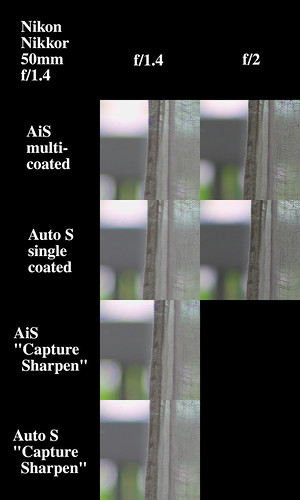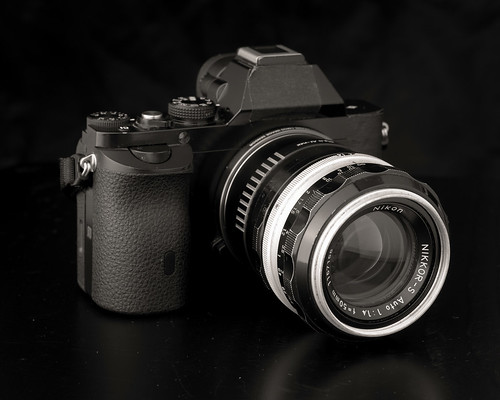Living where I do, I absolutely know much how fortunate I am to live in peace. There is mental space and physical safety to do the things I want, like write these little amount to nothing important blog entries.
Not everyone has this option these days. We receive daily reminders of this fact and it's downright heartbreaking. People are being killed for a man's out-sized sense of power, control, and entitlement. I wish peace for everyone.
Here is what Peter Turnley has been doing in the Ukraine. And here are some of his photos.-------------------------
In a prior post I compared the highlight color shift of a AiS version to a multi-coated Nikon Nikkor-S.C Auto 50mm f/1.4. It appears the designs are different between the early S Auto and more recent AiS. The color shift I saw was in the newer optic.
There's a small problem with the S.C Auto I have as the focusing ring is very very stiff. So I bought a single-coated version for very little money in the hope that the focusing ring would turn correctly.
The little lens arrived and the condition is better than I ever imagined. The glass in this c.1972 optic is pristine. The focusing ring turns smoothly and correctly. The aperture blades are dry and "snappy."
With the S.C Auto out of action until I can drill out two retaining screws I compare here the Nikkor-S Auto against the AiS version.
Setup -
- Sony A7 - ISO100, 2 second timer, in-camera levels used to square the whole plot up
- Manfrotto tripod - it's capable of securing an 8x10inch view camera, so it's sturdy enough for this
- Lenses -
- Nikon Nikkor-S (single-coated) Auto 50mm f/1.4 pre-Ai c.1972
- Nikon Nikkor 50mm f/1.4 AiS c.1984
- Rawtherapee "Auto Match"
Comparison -
Here is the scene setup. It's just a pair of closed gaze scrims in our apartment. The details are interestingly small, so therefore useful for this kind of "wee look-see."

[As always, click on the image and look at it to 100percent file size to see whatever there is to be seen.]

Comments -
Note: Please keep in mind I'm comparing single examples of lenses. It's not like I have a deep repository of samples and examples of all these optics. What I see in the lenses in my possession might not be seen in other people's copies. And, as with my Lens Turbo II studies, not all effects are attributable to the primary optic.
The Nikon Nikkor 50mm f/1.4 AiS still shows a strong purple cast in the curtain from the extremely bright highlights at f/1.4. At f/2 this strong purple cast appears to be much better controlled.
The Nikon Nikkor-S 50mm f/1.4 Auto, on the other hand, shows well controlled color shifts in the highlight to shadow transition areas. It looks as good to me as the multi-coated Nikkor-S.C Auto. When pixel-peeping at 100percent file size the overall image is a little softer to my eyes than the AiS version. Though I don't show it here, the AiS sharpness advantage over the Nikkor-S Auto is gone by f/2.8.
Something I noticed recently is how similarly the AiS f/1.4 and f/1.8 Nikkors render. Both show this strong purple cast in the bleed from highlight regions when shot wide open.
If you look at the specific implementations of the plasmat
design, both AiS lenses have elements 2 and 3 air-space separated. The
earlier/older Nikkor-S and S.C Auto design, on the other hand, have elements 2 and 3 cemented as a doublet. I wonder what design trade-offs were made between them? Did Nikon trade a bit of chromatic aberration off against improved resolution at f/1.4?
I also include a Rawtherapee "Capture Sharpen" comparison. The softer Nikkor-S Auto looks really good and the AiS looks nearly "wickedly" sharp after a little "Capture Sharpen." If you don't like the Nikkor-S softness wide open, here's a fix, though I would be careful. I'm now leaning in the direction that "Capture Sharpen" might have an effect on the overall rendition of a lens by correcting some of the more interesting faults that give an optic their various signature characters.
It would be fair to ask why I'm going through all this trouble to try and understand what's going on. One answer would be that I'm chasing pixies. Another answer is a little more complex.
I really enjoy photographing vehicles. In direct sunlight and indoors where pin-point light sources are often used, automobiles and motorcycles can have very strong specular highlights off of shiny surfaces and edges. Of course I would like to avoid having to use chromatic aberration corrections in software if I can during processing. So if I could select a "good" lens to begin with I will avoid having to take additional processing steps later.
Having chased my tail in circles around (currently) inexpensive, widely available lenses I've come to consider the idea that it might be interesting to shoot just one lens on one camera for awhile to see what happens.
It won't happen, of course. My other lenses would revolt for the lack of attention. Besides, others have done a lot of this OL/OC/OY kind of thing.
However, I will be using this old single coated lens for as long as it takes to see what it can do. Someone who wrote about Leica lenses many years ago suggested it takes about a year of use before a person really knows if a lens is "good" and will stay in the kit or not.



No comments:
Post a Comment